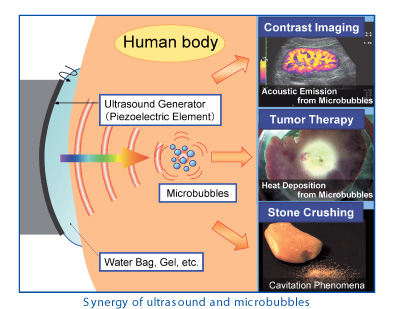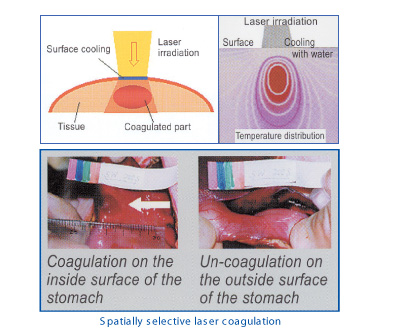 |
 |
|
|||||||||||||||||||||||||
|
| Noninvasive or minimally invasive medical therapy |
| Non-invasive Treatment with Ultrasound |
 Yoichiro Matsumoto, Professor Yoichiro Matsumoto, ProfessorDepartment of Mechanical Engineering Recently, Ultrasound is widely applied for the less-invasive treatment, and microbubbles are also closely tied to the diagnosis or therapeutic use. For diagnostic applications, their large sound scattering property yields improved imaging, where the microbubbles are used as contrast agents. The harmonics responses from the bubbles assist in distinguishing the acoustic scattering of blood from that of the surrounding tissue. For one of the therapeutic applications, the heat coagulation of tumor site has been investigated. HIFU (High Intensity Focused Ultrasound) has attracted much attention, and microbubbles in HIFU field can convert the mechanical energy of ultrasound into heat. The heat generated by the bubbles contributes an enhanced heating effect, and the treatment with lower power ultrasound can be realized. The treatment of crushing renal stone has also been developed. The violent collapse of cavitation bubbles generated by ultrasound has the potential of inducing tissue traumas. The new method of crushing has been investigated: the cavitation is located only at the stone surface, and erodes only the stone, not the tissue. The fragments are sufficiently small to pass through the urethra. The synergy of ultrasound and microbubbles has a potential to be applied to DDS (Drug Delivery System), gene transfer and so. |
 |
| A New Methodology for Spatially Selective Laser Coagulation |
 Masahiro Shoji, Professor Masahiro Shoji, ProfessorDepartment of Mechanical Engineering A new low-invasive laser coagulation system is developed by irradiating the gastric wall from the serosal side combined with synchronous serosal cooling that can produce deep thermal coagulation without transmural damage. Basic analysis, fundamental as well as animal experiments were conducted to ascertain whether this system could coagulate the musoca and submucosa with acceptable injury to the muscular layer and serosa. Cauterization of the mucosa and submucosa with acceptable muscle layer damage was achieved in selected setting to find that this method is a promising, novel, minimally invasive treatment for submucosal cancer. |
 |
Page top |